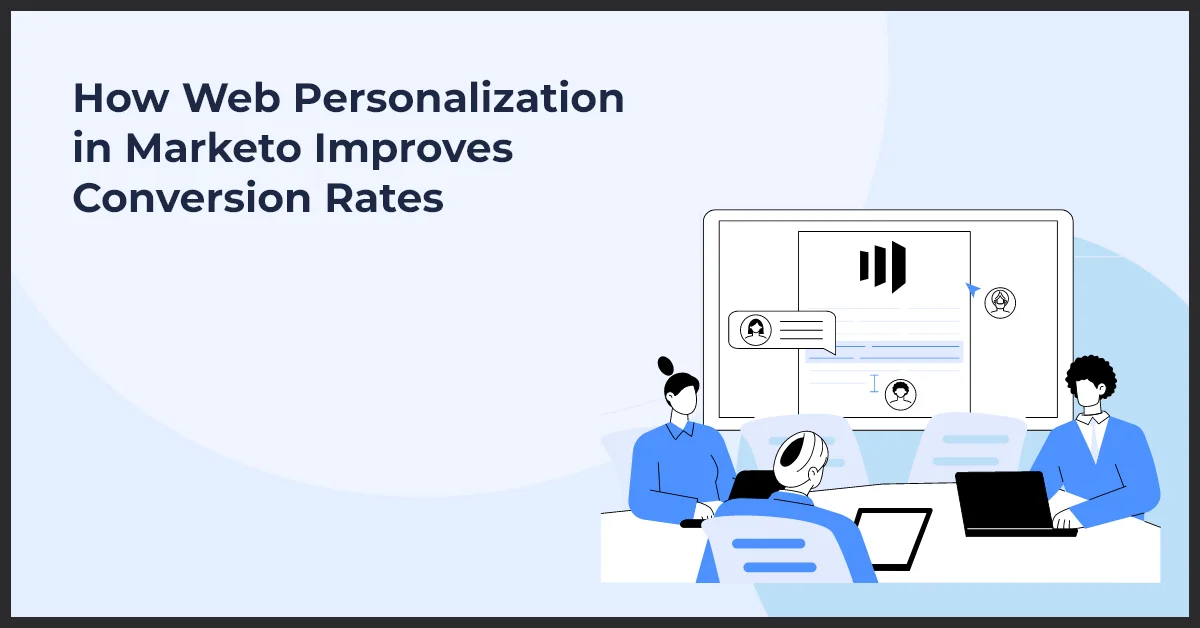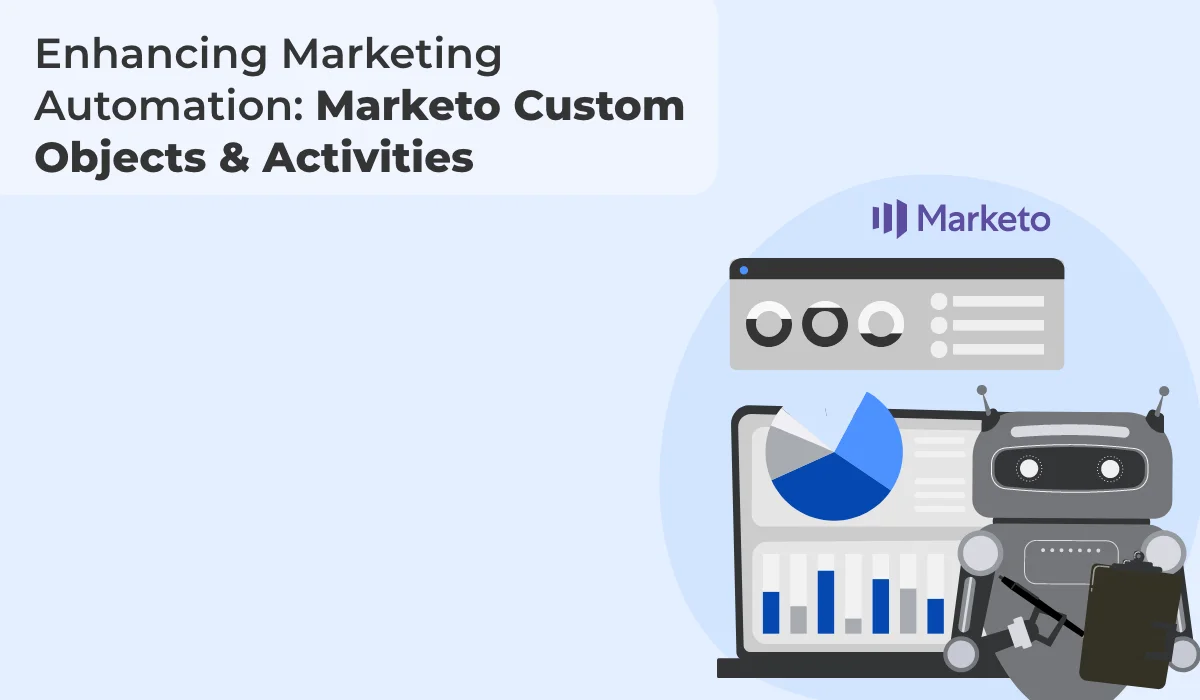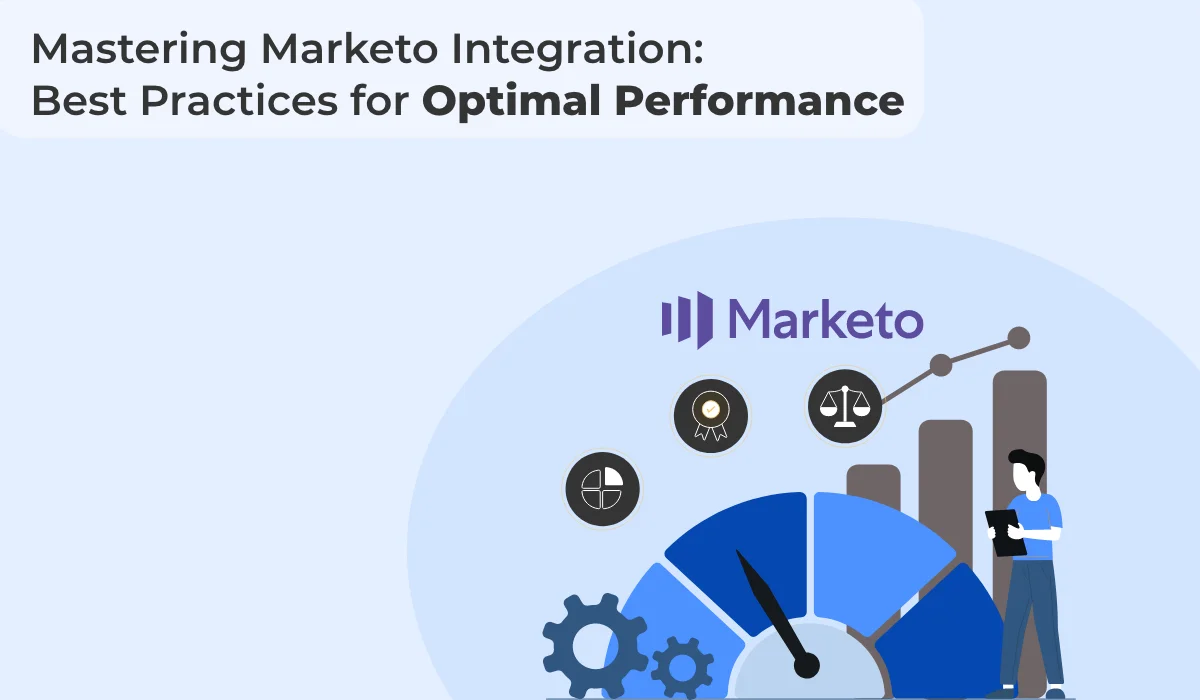Marketo Predictive Content: Personalize and Optimize Your Marketing Efforts

Published on: July 18, 2023
Updated on: February 24, 2025
2740 Views
- Marketo
16 min read
Marketo is a robust marketing automation platform that facilitates personalized, predictive content. Its use of predictive analytics (and content) employs AI-driven insights to predict audience behavior and preferences, delivering targeted content. With Marketo predictive content, businesses can automatically tailor messaging based on user interactions, ensuring relevant and engaging experiences.
This approach is revolutionizing B2B marketing, driving higher engagement, boosting conversions, and providing a more personalized customer journey, enhancing overall marketing strategies.
What exactly is Predictive Content? How does Marketo enable these new tools to be at the forefront of B2B digital transformation?
Read on to find out more.
Predictive Analytics: The Future of Content and Marketing
Predictive content is linked to technology-driven predictive analytics that, as the name suggests, predicts future events. It leverages techniques like data mining, modeling, machine learning, statistics, and artificial intelligence to analyze current data and extract meaningful insights. It forecasts future risks, opportunities, and outcomes by deciphering intelligence from past patterns, interactions, and correlations in structured and unstructured data. The content generated on this model is predictive content.
Customizing Content Based on Predictive Segmentation
Predictive Content is the new radical approach in today’s B2B marketing world. It aims to eliminate human intuition and manual data analysis in defining segments and establishing targeting rules. Predictive segmentation, also known as "data-driven" or "AI-based" segmentation, results from using machine learning to define segments based on your goals and what you want to achieve.
Three primary methods used in developing such content are:
- Clustering: Clustering algorithms, an unsupervised machine-learning method, can help identify and comprehend various user personas or segments based on shared attributes. While this technique is primarily exploratory and doesn't provide ROI or predict responses to diverse experiences, it is an effective initial step for data-driven personalization.
- Classification: Machine learning comprises supervised and unsupervised types, with classification algorithms under supervised learning. These use a dataset's "features" (e.g., device type, pages visited, company size) to predict outcomes (like conversions, revenue, or LTV) using various algorithms like linear or logistic regressions, random forests, and neural networks. Employing this method requires a skilled analyst to correctly fit your data into a model, or tools like Squark or DataRobot can be used.
- Experimentation and Predictive Segmentation: Identifying profitable user segments can be achieved through controlled experiments and tools that highlight promising segments. For example, Conductrics offers an interpretable decision tree showing conversion probabilities for individual segments per variant tested. Tools visually showing targeting rules, estimated ROI, and success probability are particularly useful. This method provides the probability of success and the discretion to target a segment based on its value.
Predictive segmentation is the first step in generating predictive content to target audiences based on their past behavior and forecasted future needs.
How is the efficacy of this method measured and analyzed to generate further fine-tuned predictive content?
The next section has some answers.
Pro Tip: Consistently Utilize A/B testing and experimentation alongside predictive segmentation to continuously refine and optimize targeting strategies. By testing different variations and analyzing their performance, you can identify the most effective approaches for engaging specific audience segments, leading to improved predictive content generation and enhanced marketing outcomes.
Measuring and Analyzing Predictive Content Performance
Initiating a predictive analytics project involves clear goal-setting and aligning these with key performance indicators (KPIs) to align the project with business objectives.
Important metrics include precision, accuracy, recall, ROI, customer satisfaction, and employee engagement.
Testing and validating the predictive model before deployment ensures reliability and validity. It can be done through data segmentation, cross-validation techniques, performance assessment on different data subsets, and stakeholder feedback.
After deployment, it's crucial to consistently monitor and improve the model, fix errors, and update with new data as needed. Regular reviews and audits of the model's quality and value are beneficial, and sharing results with stakeholders and end-users is also important.
Case Study: TechConnect and Marketo's Predictive Content
TechConnect, a global software company, has long been recognized for its superior products. However, it faced a significant challenge: its diverse range of software solutions catered to various industries and sectors, making it challenging to reach its equally diverse customer base with the right content at the right time.
Their marketing team had a clear goal: optimize the buyer journey, increase customer engagement, and drive conversions. However, their previous content marketing strategy – manually segmenting audiences and sending generalized content – did not yield the desired results.
After analyzing their situation, TechConnect decided to leverage the power of predictive content in Marketo to deliver more personalized and impactful content to their prospects and customers.
Implementation and Strategy
TechConnect started by defining its goals to increase customer engagement, boost conversions, and reduce the sales cycle length. They then integrated Marketo's predictive content tool with their CRM and existing marketing technologies, ensuring a seamless data flow.
The company's marketing team set about tagging existing content assets in Marketo based on industry, product, and buyer's stage. The predictive content tool analyzed visitor behavior, including the pages they visited, the downloads they made, and the emails they opened. It also considered demographic details from the CRM. Using machine learning, the tool predicted which content was most relevant to each visitor and delivered it accordingly via the website, email campaigns, or other digital channels.
Results and Impact
The results of TechConnect's predictive content strategy were impressive:
- Increased Engagement: By delivering tailored content, TechConnect saw a significant increase in customer engagement. Their email click-through rate increased by 30%, and the bounce rate on their website reduced by 20%.
- Improved Conversion Rates: TechConnect increased its conversion rates by 15% by providing personalized content that addressed each buyer's unique needs.
- Reduced Sales Cycle: Personalized and predictive content also helped potential buyers find what they needed faster, reducing the sales cycle length by 25%.
- Efficiency: Automating personalized content delivery saved the marketing team countless hours previously spent on manual segmentation and selection.
This case study highlights how predictive Marketo content can transform a company's marketing strategy. TechConnect's experience demonstrates the potential for predictive content to increase engagement, improve conversions, and optimize the buyer's journey, especially in a B2B context. It's a testament to the power of personalization and the role that data-driven strategies can play in driving business growth.
Pro Tip: Regularly review and iterate upon predictive content strategies based on performance metrics and stakeholder feedback. Continuously refining and optimizing content delivery ensures sustained improvements in customer engagement, conversion rates, and sales cycle efficiency, driving long-term business growth and success.
Step-by-step Guide to Installing Predictive Content in Marketo
You will find these Predictive Content features in Marketo:
Predictive Content
Predictive Content Summary
The Predictive Content Summary provides a quick overview of your predictive content, featuring tables, graphs, and the latest statistics.
Top Bar
This area displays the current count of content and views and the number of activated pieces. In the top right corner, you can choose to see data from the past 7 or 30 days for the whole page.
Performance Table
This section lets you view your top 10 discovered content pieces, their views, direct leads, and conversion rates.
Predictive Engagement
Here, you can assess your conversion rate by comparing total clicks with direct leads and contrasting the performance of various sources.
Content Trend by Views
Compare how your views of all content match up with your predictive content.
You can also check out the top categories of most engaging content in a graph.
Define a Smart List for Predictive Content Activities
Predictive content activities can be employed in triggers and filters while setting up a smart list in a smart campaign. An action can be triggered for any user interacting with predictive content through the Rich Media template, the Content Recommendation Bar, or an email.
- Go to the Smart List tab within your smart campaign.
- Look for the trigger, then drag and drop it into the canvas area.
- From the Name drop-down menu, choose an operator.
- Establish the trigger.
- Incorporate the Type constraint.
- Choose the required source for your smart list.
- Include the Clicks Link in the Email trigger if you use the email source for your predictive content. Pick your email and apply the Is Predictive constraint, which is set as true.
- Introduce any other necessary filters.
Predictive Content Analytics Overview
Leverage content analytics to delve deeper into your current content, understand (based on AI and Predictive algorithms) what content resonates with your audience, and amplify the ROI of your marketing initiatives.
On the Summary page, select Analytics.
Analytics encompasses several sections: Top Content by Views, Top Content by Conversion Rate, Trending Content, Suggested Content, and Content.
- Hover your cursor over the question mark in any section header for more information.
- Press the export button to download the results of that section into an Excel file.
- You can filter results by characteristics (like ABM Account List, Country, etc.).
- Use the calendar icon to modify the dates for the displayed data. Select a fixed period or a specific date range.
Top Content by Views
It shows the most viewed content pieces for the selected date range.
Top Content by Conversion Rate
It highlights the highest converting content by conversion rate for the chosen date range.
Trending Content
This section indicates the surge in popularity of a content piece by comparing the rise in views in the last two weeks to the same preceding period.
Suggested Content
It displays content we recommend for promotion in your Marketing Activities based on your specified filter. Hover over an image in Suggested Content to view available options.
Enabling Predictive Content
It's advised to activate more than five pieces of content per category and source (email, rich media, bar) before testing and implementing Predictive Content. Greater content availability leads to more accurate predictions.
Enable Predictive Content for Web Rich Media
Predictive content uses machine learning and predictive analytics to offer the most pertinent content to your website visitors. By employing Web Rich Media, you can enrich your content with textual descriptions and images and integrate several predictive content suggestions on your site.
After preparing the content title, description, and image for Rich Media, you can activate individual or multiple pieces of content.
- To activate a single title, click on a title to bring up the editor. Click on Rich Media, then tick the box for Enabled for Predictive Content in Rich Media and click Save.
- To activate multiple pieces of content, go to the Predictive Content page and check the boxes next to the title(s).
- Click the Content Actions drop-down and select Enable for Web-Rich Media.
Customize the Javascript Code and incorporate it into your Website. For guidance on customizing the template for your website, consult the Rich Media Recommendation template documentation on the Marketo Developers site.
Insert the JavaScript code into the desired location on your website where you want the template to display.
Template Examples
Template1: Three horizontally arranged content pieces with images, header, and description
Template2: Three vertically arranged content pieces with images, header, and description
Enable Predictive Content in Emails
Personalize your emails by making one or more images predictive, thereby customizing the experience for each recipient.
Incorporating Predictive Content with the Email 2.0 Editor
- Select Marketing Activities.
- Choose your email and hit Edit Draft.
- Click the image you wish to make predictive. When the gear icon pops up, select Enable ContentAI (ContentAI was the old name for Predictive Content).
- To pick one or more categories, hit the Categories drop-down, make your selection(s), and click Apply.
- Your image is now predictive. Repeat steps 3 and 4 for additional images (if needed).
- To see a preview of your email, click Preview in the top-right corner.
- To view alternative potential images, click Refresh.
- Once you've finished previewing your email, hit the Preview Actions drop-down and select Approve and Close. If you still need to edit, click Edit Draft on the right.
After you approve your email, it will be outfitted with predictive content and ready to dispatch!
Incorporating Predictive Content Without Using the Email 2.0 Editor
If you're not utilizing an Email 2.0 template, add Predictive Content to your email by marking an image in your template as a Marketo editable image element.
Enable the Content Recommendation Bar
The Content Recommendation Engine employs predictive analytics and machine learning algorithms to offer each web visitor tailored content. The engine forecasts the best-performing content for each visitor. Content for this engine is supervised and managed from the Recommendations page, assisting you in maximizing your content ROI.
Activating and Personalizing the Content Recommendation Bar
- Navigate to Content Settings.
- Select Bar.
- To activate the Recommendation Bar for a URL, just click On and then Save.
- To personalize a URL, choose colors, style, format, arrows for the recommendation bar, and pages to either include or exclude the bar. Adjust it to match your website's branding. Click Save.
Things to Consider for the Recommendation Bar
The Recommendation engine requires at least one piece of content set to 'On' on the Recommendations page to function properly. If no content is activated and the Bar is switched 'On,' the Arrow effect will be visible on the bottom right of the webpage, but no suggested content will show.
More content processed through the recommendation engine enhances the algorithm's ability to test and determine the most effective content. We suggest you start with 10 to 20 active content pieces and continue adding new ones.
The content piece you activate for a recommendation should contain the RTP Javascript tag. It assists the algorithm in tracking and optimizing recommended content.
Working with Predictive Content
Understanding Predictive Content
Once you've approved a title for predictive content, you manage it on the Predictive Content page. This page showcases all the titles given a green light for predictive content use.
1. Fields on the page include
Image and Title: The selected image and the content piece's title
Enabled by Source: Indicates whether the title is approved for Rich Media, email, or the Recommendation Bar.
Categories: You create these and use them to group your predictive results for web or email.
Clicks: The total number of clicks on recommended content across all sources.
Conversion Rate: This percentage is obtained by dividing direct conversions by clicks. Hover over to see additional data (see below).
Assisted Conversion: These are visitors who clicked on recommended content in a previous visit and filled out a form later.
2. Filtering Content
Content can be filtered by the categories you've set up. Click on the filter icon, and choose one or more content categories under Category.
3. Enabled Source
Filter by each kind of enabled content: Email, Rich Media, Recommendation Bar.
4. Analytics by Source
Filtering the analytics of enabled content lets you see the performance of each source.
5. Display Analytics by Date
Select the start and end dates on the right. Click Apply.
6. Examine Table Data for Predictive Content
The table shows which sources are activated for predictive content, from left to right: Recommendation Bar, email, and Rich Media. Enabled sources are highlighted in green. These are activated when you modify the content.
Place your cursor over the bar in the Conversion Rate column to see the conversion rate and direct conversion, and click data.
Edit Predictive Content for Emails
Here's how you can prepare your predictive content for emails.
- Click on a title on the Predictive Content page to open the editor.
- The edit page will appear with the Email displayed by default.
- You can add or modify the button label by typing it into the text box next to it.
- Click on Edit Image to add or modify the image URL.
- Add the image URL and click on Add.
- Use the slider to alter the image size. Then, move the cropping box to select the area of the image you want to use. Click on Preview when you're done.
- Use the arrows on the sides to scroll and see your content in each email layout preview (two options will be displayed).
- You can also add categories to the content by clicking on the Categories field. You can select from the categories you've previously created.
- Tick the box to enable Predictive Content in Email.
- Click on Save.
Edit Predictive Content for Web Rich Media
Here's the process to configure your predictive content for Rich Media.
- Navigate to the Predictive Content page and select a title to launch the editor.
- Choose Rich Media.
- Observe that you can use different images for Email and Rich Media. To change or add an image, enter the image URL into its corresponding text box.
- Write a Description.
- Optionally, click the Categories box to select or add previously established categories.
- Mark the checkbox to activate Predictive Content in Rich Media.
- Finally, click Save.
Edit Predictive Content for Recommendation Bar
Here's a guide to preparing your predictive content for the Recommendation Bar.
- Go to the Predictive Content page and choose a title. It will open the editor.
- Select Bar.
- Mark the checkbox to activate Predictive Content within the Recommendation Bar.
- Click on Save.
Key Takeaways
- Understanding Marketo's Predictive Content: Marketo's Predictive Content leverages AI-driven predictive analytics to anticipate audience behavior and preferences, enabling the delivery of personalized content that enhances user engagement and conversion rates.
- Implementing Predictive Segmentation: By utilizing machine learning techniques such as clustering algorithms, businesses can define data-driven segments. This approach moves beyond traditional methods, allowing for more precise targeting and personalized marketing strategies.
- Enhancing Content Personalization: Marketo's Predictive Content analyzes user interactions and behavioral data to dynamically select and deliver the most relevant content to each recipient, ensuring a personalized experience that resonates with individual preferences.
- Benefits of Predictive Content in B2B Marketing: Adopting predictive content strategies in B2B marketing leads to higher engagement, improved conversion rates, and a more personalized customer journey, ultimately driving better ROI and more effective marketing outcomes.
- Leveraging Advanced Analytics for Continuous Improvement: Marketo provides robust analytics features that allow businesses to track, measure, and optimize their predictive content efforts. By analyzing performance metrics, companies can refine their strategies to better align with audience needs and preferences.
Conclusion
Predictive content in Marketo uses artificial intelligence (AI) to predict the most appropriate content to serve a specific visitor based on their behavior, demographic details, and other related data points. The tool uses machine learning algorithms to analyze these data sets and deliver personalized content, thereby increasing the chances of engagement, conversion, and customer retention. Leveraging advanced tools and innovative strategies can propel your business to new heights.
Growth Natives is here to help you implement and unleash the power of predictive content in Marketo for your business. Email us at info@growthnatives.com or call +1 855-693-4769 and watch how much more you can learn about your customers and their needs.
Frequently Asked Questions
Predictive content in Marketo email refers to dynamically personalized content tailored to each recipient based on their past behavior, preferences, and demographic details, leveraging predictive analytics and machine learning algorithms.
Predictive content marketing utilizes data-driven insights and predictive analytics to deliver personalized and relevant content to target audiences, increasing engagement, conversions, and ROI.
Predictive send optimization in email involves using predictive analytics to determine the optimal time to send emails to each recipient based on their past behavior and engagement patterns, maximizing open and click-through rates.
To increase email deliverability in Marketo, focus on maintaining a clean email list, using double opt-in processes, personalizing sender names and content, avoiding spam trigger words, and regularly monitoring email performance metrics.
Marketo tracks email clicks through unique tracking URLs appended to each link in the email, allowing it to capture click data and attribute it to individual recipients.
Predictive content search involves using predictive analytics to anticipate and suggest relevant search results or recommendations to users based on their past behavior, preferences, and search history.
The benefits of predictive marketing include improved targeting and personalization, increased engagement and conversions, enhanced customer satisfaction and loyalty, optimized resource allocation, and higher ROI on marketing efforts.
An email marketing targeting strategy involves segmenting your email list based on demographics, behavior, interests, and purchasing history to deliver personalized and relevant content to each segment, maximizing engagement and conversions.



